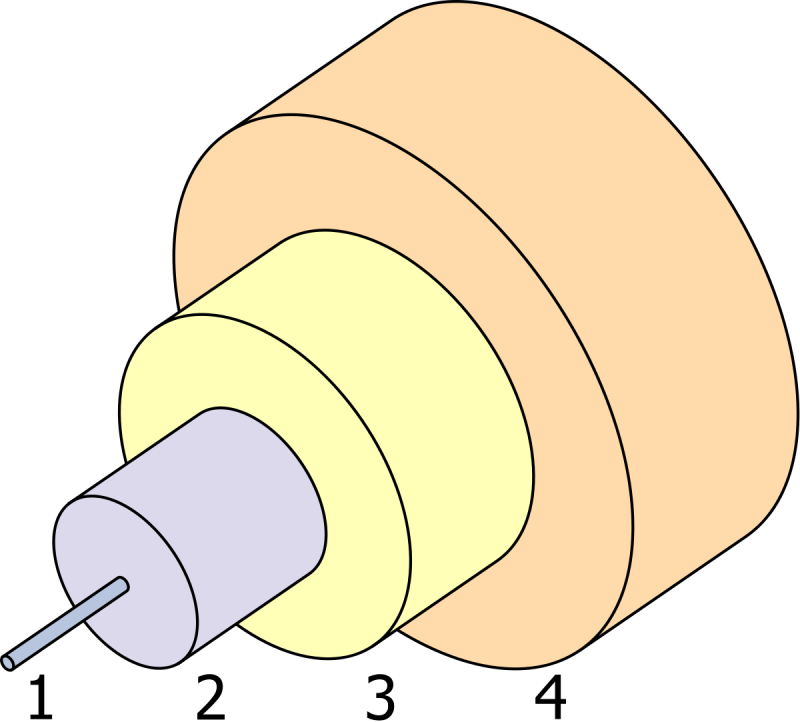Fiber optic technology has revolutionized the way we transmit data, providing high-speed and high-capacity communications that are critical in today’s information-driven world. One of the key components of this technology is single-mode fiber optic cable. In this blog, we’ll explore what single-mode fiber optic cables are, their types, a buying guide, tips, uses, and frequently asked questions.
What is Single-Mode Fiber Optic?
Single-mode fiber optic (SMF) is a type of fiber optic cable designed to carry light signals directly down the fiber with minimal dispersion and attenuation. The core diameter of a single-mode fiber is much smaller than that of multi-mode fiber, typically around 8 to 10 micrometers (µm). This small core size allows the light to travel a single path (mode) which significantly reduces signal loss and maintains the integrity of the transmitted data over long distances.
Key Characteristics:
Core Diameter: Approximately 8-10 µm.
Cladding Diameter: 125 µm.
Wavelengths: Commonly operates at 1310 nm and 1550 nm wavelengths.
Bandwidth: Higher bandwidth than multi-mode fiber.
Distance: Ideal for long-distance communication, often several kilometers.
Types of Single-Mode Fiber Optic
Single-mode fibers are generally categorized based on their performance characteristics and the standards they adhere to. The primary types include:
OS1 (Optical Single-mode 1):
Description: Designed for indoor use, OS1 fiber typically has a tighter attenuation (1 dB/km) and is suitable for use up to 10 km.
Applications: Used in premises cabling, campus networks, and data centers.
Compliance: Adheres to ITU-T G.652 standard.
OS2 (Optical Single-mode 2):
Description: Suitable for outdoor and long-distance applications, OS2 fiber has a lower attenuation (0.4 dB/km) and can be used for distances up to 200 km.
Applications: Ideal for telecom networks, long haul applications, and metropolitan networks.
Compliance: Complies with ITU-T G.652 standards and is optimized for longer wavelength (1550 nm).
ITU-T G.657:
Description: Bend-insensitive single-mode fibers designed to be less sensitive to bending losses.
Applications: Ideal for FTTH (Fiber to the Home), FTTx (Fiber to the X), and densely packed environments.
Types: G.657.A1 and G.657.A2 (more bend-insensitive than G.652).
Buying Guide for Single-Mode Fiber Optic Cables
When purchasing single-mode fiber optic cables, several factors must be considered to ensure you get the right type for your specific needs:
Application Requirements:
Determine whether your application is for indoor, outdoor, or a combination of both.
Consider the distance over which the data will be transmitted.
Cable Specifications:
Core Size: Typically, single-mode fiber has a core size of 8-10 µm.
Cladding Diameter: Standard cladding diameter is 125 µm.
Attenuation and Bandwidth: Ensure the fiber meets the attenuation and bandwidth requirements for your application.
Standards Compliance:
Ensure the fiber optic cable complies with relevant standards such as ITU-T G.652, G.657, etc.
Environmental Conditions:
Consider whether the cable will be exposed to extreme temperatures, moisture, or mechanical stresses.
For outdoor use, ensure the cable is UV-resistant and waterproof.
Bend Radius:
For installations with tight bends, opt for bend-insensitive fibers like ITU-T G.657.
Tips for Using Single-Mode Fiber Optic Cables
Proper Installation:
Follow manufacturer guidelines for installation to avoid damaging the fibers.
Ensure connectors are clean and properly aligned to prevent signal loss.
Handling and Bending:
Avoid excessive bending; follow the minimum bend radius specifications.
Use bend-insensitive fibers in environments where tight bending is unavoidable.
Testing and Maintenance:
Regularly test the fiber optic links for attenuation and signal loss.
Clean connectors periodically to maintain optimal performance.
Splicing and Connectors:
Use high-quality splicing techniques and connectors to ensure minimal loss and reflection.
Fusion splicing is preferred for permanent connections due to its low loss.
Uses of Single-Mode Fiber Optic Cables
Telecommunications:
Backbone of telecommunication networks, enabling long-distance and high-speed data transmission.
Internet Infrastructure:
Essential for providing high-speed internet connectivity across cities, countries, and continents.
Cable Television (CATV):
Used for transmitting television signals over long distances with high quality.
Medical Imaging:
Utilized in medical devices and imaging technologies such as endoscopes.
Military and Aerospace:
Applied in secure and high-performance communication systems in defense and aerospace sectors.
Data Centers:
Facilitates high-speed data transfer and connectivity between servers and storage devices.
FAQs about Single-Mode Fiber Optic
- What is the difference between single-mode and multi-mode fiber optic cables?
Single-mode fibers have a smaller core size and allow light to travel in a single path, making them suitable for long-distance transmission. Multi-mode fibers have a larger core, allowing multiple paths of light, which limits their transmission distance but makes them suitable for shorter, high-bandwidth applications.
- Why is single-mode fiber preferred for long-distance communication?
Single-mode fiber has lower attenuation and dispersion, which means it can transmit data over longer distances without significant signal loss.
- Can single-mode fiber optic cables be used indoors?
Yes, single-mode fibers like OS1 are designed for indoor use and can be employed in data centers, building cabling, and other indoor applications.
- What is the typical lifespan of a single-mode fiber optic cable?
Single-mode fiber optic cables can last over 25 years if properly installed and maintained, although this can vary based on environmental conditions and usage.
- How do I test single-mode fiber optic cables?
Testing can be done using an Optical Time-Domain Reflectometer (OTDR) to measure loss, reflection, and other performance metrics. Regular testing is recommended to ensure optimal performance.
- Are single-mode fiber optic cables bend-insensitive?
Standard single-mode fibers are sensitive to bending, but bend-insensitive variants like ITU-T G.657 are available for installations requiring tight bends.
Single-mode fiber optic cables are a cornerstone of modern communication infrastructure, offering unparalleled performance for long-distance and high-speed data transmission. Understanding the different types, appropriate usage scenarios, and maintenance tips can help you make the most of this advanced technology. Whether you’re setting up a telecommunications network, enhancing data center connectivity, or deploying fiber to the home, single-mode fiber optic cables provide the reliability and efficiency required for today’s data-driven world.
Contact Linden Photonics to get a single mode fiber optic quote or Call Us at (978) 392-7985



3 comments
avenue17
05/05/2023 at 10:08 pm
What remarkable words
Pingback: What is Fiber Optic Cable and Types? - Linden Photonics Inc
Dianady
11/27/2023 at 7:08 am
This article was a great introduction to single-mode fiber optics. As someone new to the field, I found it very helpful. It’s interesting to see how single-mode fiber has revolutionized data transmission and connectivity. I’m curious about the cost implications of using different types of single-mode fibers. Are some types more cost-effective than others for specific applications?
When comparing prices for products or services, it’s crucial to carefully analyze your business needs to ensure you’re making a cost-effective choice. Consider factors such as quality, features, scalability, and long-term value to determine which option aligns best with your specific requirements. By conducting a thorough evaluation, you can make informed decisions that benefit your business both in the short and long term.